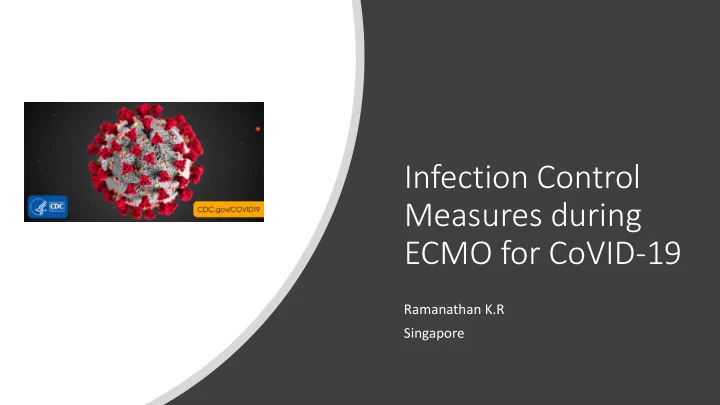

Infection Control Measures during ECMO for CoVID-19 Ramanathan K.R Singapore
Ideal PPE to be used when managing confirmed/ suspected COVID-19 positive intubated patient with ECMO
• World Health Organization guidelines : DROPLET precautions for routine care of COVID19 patients. AIRBORNE precautions for aerosol-generating procedures (e.g. intubation, extubation, bronchoscopy, and tracheostomy). • United States CDC previously recommended using AIRBORNE precautions when managing COVID19 patients. CDC recent statement: surgical facemasks acceptable when N95 masks run out. • ANZICS recommends AIRBORNE precautions be used for critically ill patients with COVID-19.
Vs Acknowledgement: Peter Lai, Hong Kong
N95 Vs PAPR Vs Standard mask
Hospital/ Local Health Authority guidelines
Infection Control Practices for ECMO patients • Essential components • ECMO centres should revisit their existing infection control guidelines • Ensure that all members of the ECMO team receive adequate training. • Personnel performing ECMO cannulation and decannulation must wear sterile attire in addition to personal protection devices.
Desirable • ECMO centres should consider developing facility-level plans to group such patients. • Harmonised infection-control practices in regional hospitals : standardized approach to personal protection devices.
Feasibility of remote monitoring/control during the ECMO run
Transport of COVID-19 ECMO patients
Inter hospital transport Intrahospital transport: • Eligibility criteria (specific to the ( Cathlab, CT scans, Operating Room) current outbreak) for inter-hospital • Risk-benefit profile : possibility of transfer. disease dissemination to health- • Rapidity of disease progression care workers and the public. from dyspnoea to ARDS is short : • Strict continuous adherence to recommend early transfer (eg, infection control policies with after tracheal intubation) to an immediate disinfection of the route ECMO centre, if feasible. and transport vehicles. • If ECMO needs to be initiated in a peripheral hospital, the ECMO team should be aware of the local resources. • Guidance for preparing the patient should be forwarded to the local hospital to shorten turnaround time. Any rate-limiting steps should be identified early.
Evidence for viral load and risk for infections transmission through blood and other body fluids Courtesy: www.nurse.com
• COVID -19 could be transmitted via respiratory, fecal-oral, or body fluid routes. • Double bagged, transported in a special box to the lab by hand
Questions?
Recommend
More recommend